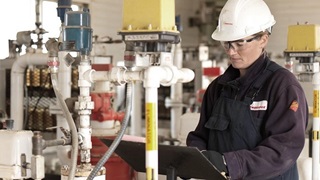Striving for sustainability through carbon and energy efficiency
Enbridge moves up to No. 39 overall, named to Global 100 index for eighth straight year
There’s talking about carbon footprint reduction. And then there’s lacing up and moving forward.
Enbridge recognizes that climate change is a global issue. We’re addressing that issue with a long-term, all-of-the-above energy supply strategy that includes renewable energy, natural gas and crude oil.
At the same time, we’re taking a proactive approach to reducing our own carbon footprint—by setting and working toward company-wide targets for greenhouse gas (GHG) reductions and improving energy efficiency.
“These company targets send a strong signal regarding the depth of our commitment to managing climate risks—and bringing low-carbon energy solutions to scale,” says Linda Coady, Enbridge’s Chief Sustainability Officer.
Our work toward setting carbon and energy efficiency targets is one of many reasons that Enbridge was named today to the Global 100 Most Sustainable Corporations list for the eighth straight year. The announcement was made during the World Economic Forum in Davos, Switzerland.
Enbridge earned the No. 39 spot overall for 2017—our highest placement on the annual international index, and seven spots up from our previous high of No. 46 in 2016. Six Canadian companies made the grade this year, including the Royal Bank of Canada (No. 37) and Sun Life Financial (No. 45).
Enbridge is the only Canadian energy-sector company on this year’s list.
The Global 100 index is a well-established international standard for evaluating corporate performance on key social and environmental issues.
Corporate Knights, which manages the Global 100, analyzed nearly 5,000 companies against their global industry peers to determine this year’s list—and added two key performance indicators, supply chain impact and clean air impact, for a total suite of 14.
Those sustainability indicators also include:
- Energy, carbon, water and waste intensity;
- Workplace safety performance;
- Employee compensation, turnover and pension plans; and
- Capacity for innovation.
In 2016, Enbridge’s corporate sustainability team worked with all of our business segments to develop current and projected GHG emissions and energy consumption profiles.
These profiles will provide the foundation for multi-year Carbon and Energy Efficiency (CEE) plans—addressing both direct and indirect GHG emissions under our operational control—that will act as a long-term road map for Enbridge, identifying cost-effective opportunities to reduce GHG emissions intensity and improve energy efficiency.
“In the minds of many, responsible and sustainable energy development is firmly linked to a lower-carbon future,” says Coady. “Enbridge is committed to playing a leadership role in this regard.”










